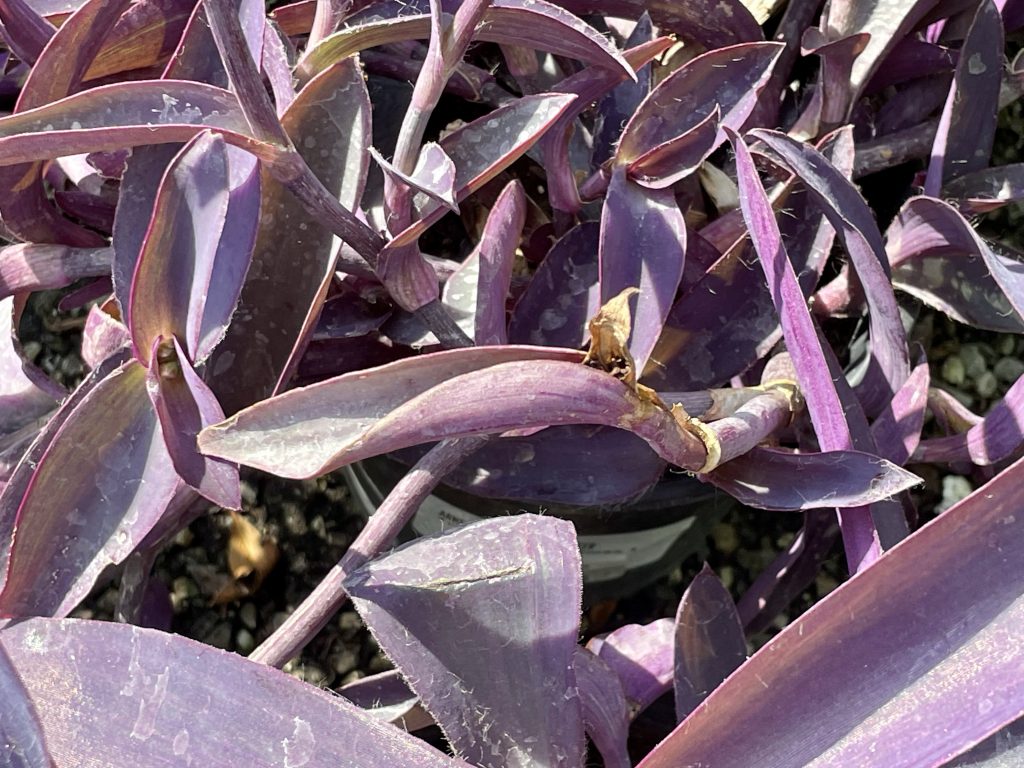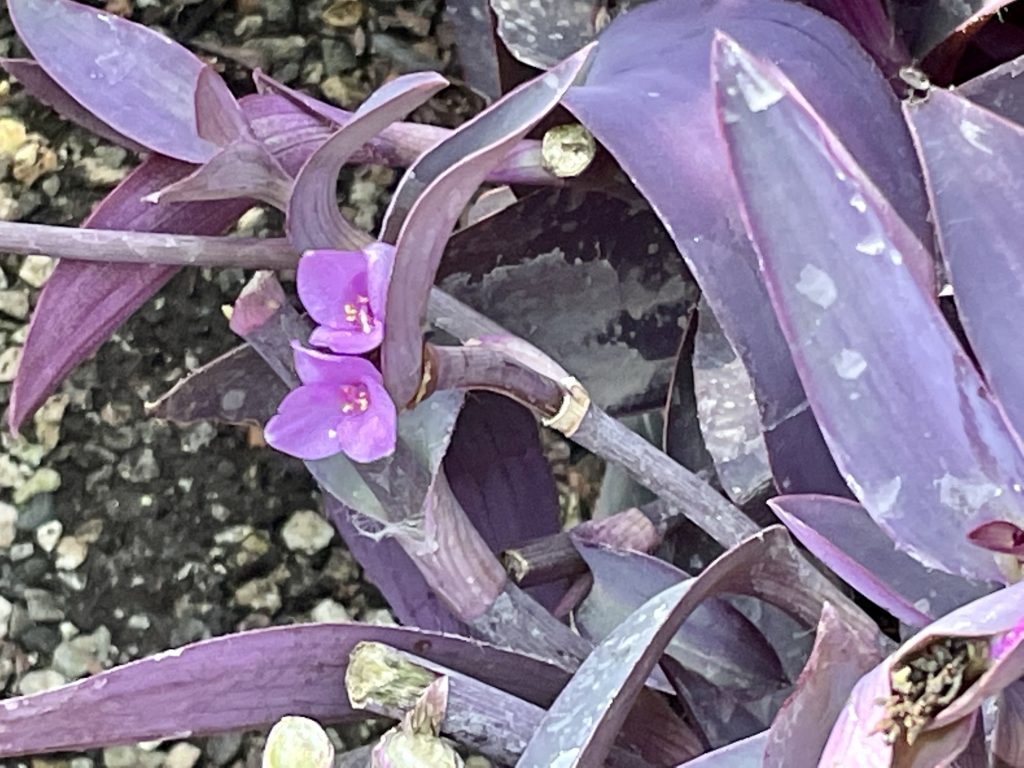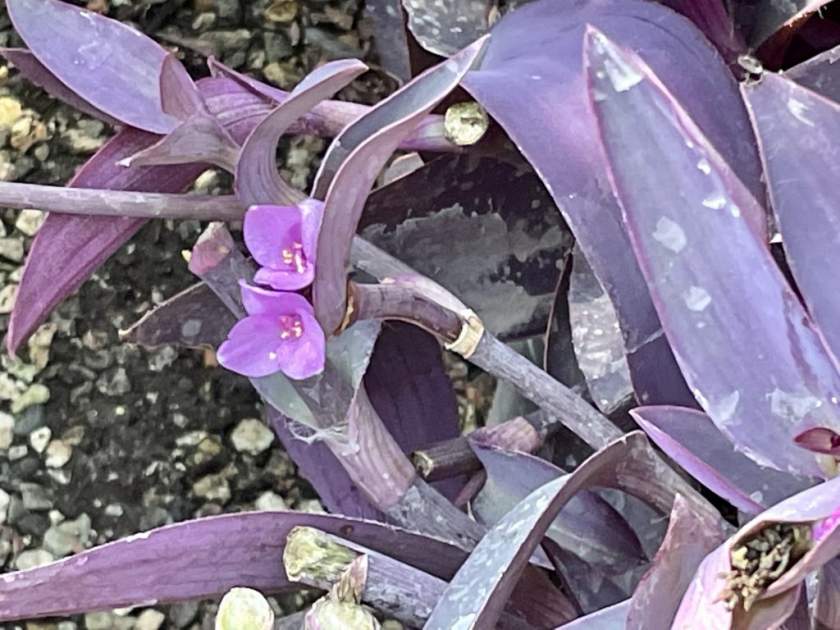Tradescantia pallida ‘Purpurea’ is a ground cover from the Commelinaceae family of plants. It is a perennial native to Mexico. They also call it the Spider Lily, Purple Queen, Wandering Jew ‘Purpurea’, Purple Spiderwort, Setcreasea purpurea, Setcreasea tampicana, Tradescantia purpurea, Purple Heart.
Pallida means pale. The name purpurea refers to the purple color and the genus is named after John Tradescant (1570-1638) and his son of the same name, both English botanists and gardeners to Charles I.
It grows to about 8in or 20cm tall. Tradescantia pallida ‘Purpurea’ has thick but fragile stems and leaves that are narrow-oblong. They are deep purple in color. The flowers are pink and have three petals.

How to grow Tradescantia pallida ‘Purpurea’:
Tradescantia pallida ‘Purpurea,’ also known as Purple Heart or Purple Queen, is a captivating plant that adds a touch of vibrant color to any garden or container. By following these guidelines, you can successfully grow and care for Tradescantia pallida ‘Purpurea’ and enjoy its striking foliage and resilience.
Sunlight and Partial Shade: Tradescantia pallida ‘Purpurea’ thrives in both sun and partial shade. While it can tolerate some shade, the purple coloration of the plant is more intense and vibrant when it receives ample sunlight. Find a location that offers a balance of sunlight and shade throughout the day.
Soil Conditions: Plant Tradescantia pallida ‘Purpurea’ in rich, well-drained soil. Ensure the soil retains moisture but doesn’t become waterlogged. Amending the soil with organic matter, such as compost, can improve its fertility and drainage capabilities, promoting healthy growth.
Pinching and Pruning: To maintain a bushy and compact appearance, pinch the tips of the plant regularly. This encourages branching and stimulates new growth, resulting in a fuller and more attractive plant. Pinching can be done by using your fingers or pruning shears to remove the topmost portion of each stem.
Wind Protection: Provide shelter from strong winds, especially in exposed areas. Strong winds can damage the delicate foliage and hinder the plant’s growth. Placing the plant in a location shielded from strong gusts or using windbreaks can help protect it.
Ground or Container Growth: Tradescantia pallida ‘Purpurea’ can be grown in the ground in temperate regions or in containers, allowing for flexibility in placement and mobility. When grown in containers, ensure they have proper drainage holes to prevent waterlogging and choose a potting mix suitable for succulent plants.
Cold Weather Protection: In colder climates, it is important to protect Tradescantia pallida ‘Purpurea’ when temperatures drop below 50ºF or 10ºC. Consider bringing the plant indoors or providing a frost cover to shield it from chilly temperatures. During mild freezes, the plant may die back, but it will regrow once the weather warms up.
Disease and Pest Management: Tradescantia pallida ‘Purpurea’ is generally disease-free and pest-free. However, keep an eye out for common pests such as snails and caterpillars, which may occasionally feed on the foliage. Regular inspection and prompt action, such as manual removal or organic pest control methods, can help prevent significant damage.
Drought Tolerance: Once established, Tradescantia pallida ‘Purpurea’ exhibits good drought tolerance. It can withstand periods of dryness without suffering significant harm. However, during prolonged dry spells, it is beneficial to provide supplemental irrigation to ensure the plant’s vitality and promote optimal growth.
Propagation: Tradescantia pallida ‘Purpurea’ can be propagated through softwood cuttings. Select healthy stems and cut them just below a node. Remove the lower leaves, leaving a few at the top. Plant the cuttings in a well-draining potting mix, keep them lightly moist, and place them in a warm and bright location. Roots should develop within a few weeks, indicating successful propagation.
By following these guidelines, you can cultivate and care for Tradescantia pallida ‘Purpurea’ successfully. Its striking purple foliage, adaptability, and low-maintenance nature make it an excellent addition to gardens, containers, or indoor displays. Enjoy the beauty and resilience of this charming plant while incorporating it into your landscape or indoor space.





